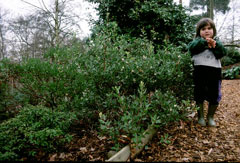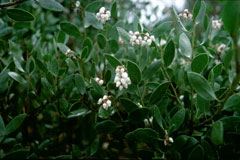 |
|
(c) 2010 Ken Fern & Plants For A Future |
 |
| (c) 2010 Ken Fern & Plants For A Future |
Translate this page:
Summary
Physical Characteristics

 Arctostaphylos manzanita is an evergreen Shrub growing to 2 m (6ft) by 2 m (6ft) at a medium rate.
Arctostaphylos manzanita is an evergreen Shrub growing to 2 m (6ft) by 2 m (6ft) at a medium rate.
See above for USDA hardiness. It is hardy to UK zone 8. It is in leaf all year, in flower from February to April. The species is hermaphrodite (has both male and female organs) and is pollinated by Bees. The plant is self-fertile.
Suitable for: light (sandy) and medium (loamy) soils and prefers well-drained soil. Suitable pH: mildly acid soils and can grow in very acid soils.
It can grow in semi-shade (light woodland) or no shade. It prefers dry or moist soil and can tolerate drought. The plant can tolerate maritime exposure.
UK Hardiness Map
US Hardiness Map
Synonyms
A. pungens manzanita. Uva-ursi manzanita.
Plant Habitats
Woodland Garden Sunny Edge;
Edible Uses
Edible Parts: Fruit
Edible Uses:
Fruit - raw or cooked[3, 46, 61]. An agreeable acid flavour but the fruit is dry and mealy[95]. Hard to digest, the fruit should be eaten in moderation[95]. It can be dried and ground into a powder[105, 161] and then used as a flavouring in soups, bread etc[213, 257]. A cooling drink can be made from the fruit[161]. The berries can be crushed to make a sweet, unfermented cider[257]. The fruit is white but becomes red-brown. These are 12 mm across [1-4].
References More on Edible Uses
Medicinal Uses
Plants For A Future can not take any responsibility for any adverse effects from the use of plants. Always seek advice from a professional before using a plant medicinally.
Appetizer Astringent Poultice Stomachic
A poultice of the chewed leaves is applied to sores and headaches[257]. The leaves are chewed as a treatment for stomach ache and cramps[257]. An infusion of the leaves is used to treat severe colds and diarrhoea[257]. A cider made from the fruit is used in the treatment of stomach complaints and as an appetizer to create appetite[257].
References More on Medicinal Uses
The Bookshop: Edible Plant Books
Our Latest books on Perennial Plants For Food Forests and Permaculture Gardens in paperback or digital formats.

Edible Tropical Plants
Food Forest Plants for Hotter Conditions: 250+ Plants For Tropical Food Forests & Permaculture Gardens.
More

Edible Temperate Plants
Plants for Your Food Forest: 500 Plants for Temperate Food Forests & Permaculture Gardens.
More

More Books
PFAF have eight books available in paperback and digital formats. Browse the shop for more information.
Shop Now
Other Uses
Dye Fuel Soap
A yellowish-brown dye is obtained from the leaves, it does not require a mordant[168]. The leaves can be boiled and the yellowish-red extract used as a cleansing body wash[257]. The wood makes an exceedingly fine fuel[257].
Special Uses
References More on Other Uses
Cultivation details
Requires a deep moist well-drained light or medium lime-free loam in sun or semi-shade but plants produce less fruit when they are grown in the shade[200]. Prefers a warm sunny position[3, 166]. Tolerates maritime exposure[49, 166, 182]. Plants are not hardy in the colder parts of Britain, they tolerate temperatures down to between -5 and -10°c[200]. Pollination is often poor in Britain[3]. Another report says that the plant does not fruit in this country[11]. This species is called A. pungens manzanita by some botanists[11]. A specimen seen at Cambridge B.G. was 2.5m tall in 1989[K]. Plants resent root disturbance and should be placed in their final positions as soon as possible[11, 134]. They can tolerate long dry periods [1-4].
References Carbon Farming Information and Carbon Sequestration Information
Temperature Converter
Type a value in the Celsius field to convert the value to Fahrenheit:
Fahrenheit:
The PFAF Bookshop
Plants For A Future have a number of books available in paperback and digital form. Book titles include Edible Plants, Edible Perennials, Edible Trees,Edible Shrubs, Woodland Gardening, and Temperate Food Forest Plants. Our new book is Food Forest Plants For Hotter Conditions (Tropical and Sub-Tropical).
Shop Now
Plant Propagation
Seed - best sown in a greenhouse as soon as it is ripe. Pre-soak dried seed in boiling water for 10 - 20 seconds or burn some straw on top of them and then stratify at 2 - 5°c for 2 months[11, 200]. Another report says that the seed requires 60 days warm followed by 60 days cold stratification[160]. The seed usually germinates in 2 - 3 months at 15°c[134]. When large enough to handle, prick the seedlings out into individual pots and grow them on in a cold frame or greenhouse for at least their first winter. Plant out in late spring or early summer. Cuttings of side shoots of the current season's growth, 5 - 8cm with a heel, August to December in a frame. Takes one year[1, 78]. Division in early spring. Take care because the plant resents root disturbance. Pot the divisions up and keep them in a lightly shaded position in a cold frame or greenhouse until they are growing away actively. Layering in spring[200].
Other Names
If available other names are mentioned here
Manzanita, Common manzanita, whiteleaf manzanita.
Native Range
NORTHERN AMERICA: United States, California,
Weed Potential
Right plant wrong place. We are currently updating this section.
Please note that a plant may be invasive in one area but may not in your area so it's worth checking.
Conservation Status
IUCN Red List of Threatened Plants Status :

Growth: S = slow M = medium F = fast. Soil: L = light (sandy) M = medium H = heavy (clay). pH: A = acid N = neutral B = basic (alkaline). Shade: F = full shade S = semi-shade N = no shade. Moisture: D = dry M = Moist We = wet Wa = water.
Now available:
Food Forest Plants for Mediterranean Conditions
350+ Perennial Plants For Mediterranean and Drier Food Forests and Permaculture Gardens.
[Paperback and eBook]
This is the third in Plants For A Future's series of plant guides for food forests tailored to
specific climate zones. Following volumes on temperate and tropical ecosystems, this book focuses
on species suited to Mediterranean conditions—regions with hot, dry summers and cool, wet winters,
often facing the added challenge of climate change.
Read More
Expert comment
Author
Parry.
Botanical References
1171200
Links / References
For a list of references used on this page please go here
Readers comment
© 2010, Plants For A Future. Plants For A Future is a charitable company limited by guarantee, registered in England and Wales. Charity No. 1057719, Company No. 3204567.